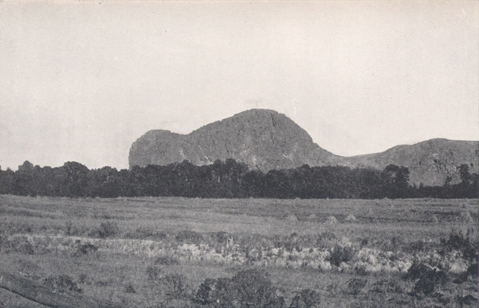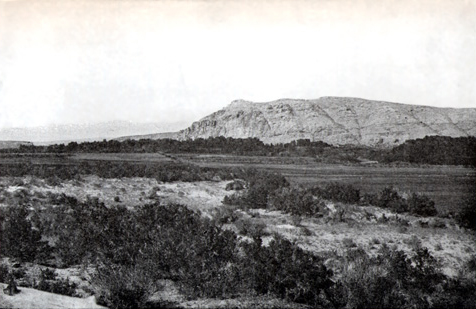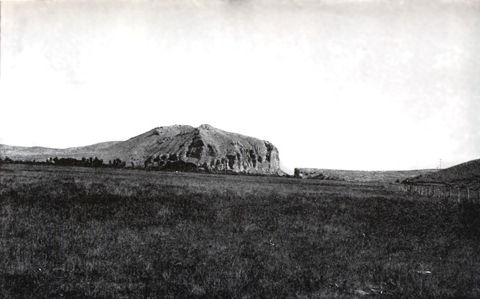Rattlesnake Cliffs
View south
Photographer unknown for Olin D. Wheeler, The Trail of Lewis and Clark. See also Wheeler’s “Trail of Lewis and Clark”.
The Rock She Meant?
Three days after stopping at his “Lookout” to get his bearings, Clark and his party, in six dugout canoes, “halted on the river under an immencely high perpendicular clift of rocks where it entered the mountain. . . . from the number of rattle snakes about the Clifts . . . we called them the rattle snake clifts.” This, however, is the landmark that white settlers believed Sacagawea really meant to identify as “Beaverhead Rock.”
Did Sacagawea misspeak? Or was she simply mistaken? Ever since the area was first settled in the 1860s, local opinion has held that either she did or she was. Moreover, it may not be much of a stretch to say that at least a small proportion of all the rocks in the west may have a “conceived resemblance” to the shape of a beaver, depending on the time of day, the angle of view, the background, and the viewer’s predisposition to anthropomorphize inanimate nature. (Notice the little “beaver shrub” at bottom-center of the last picture, above.)
“The Indian woman,” Lewis reported on Thursday, 8 August 1805, “recognized the point of a high plain to our right which she informed us was not very distant from the summer retreat of her nation on a river beyond the mountains which runs to the west. this hill she says her nation calls the beaver’s head from a conceived re[s]emblance of it’s figure to the head of that animal.” Although many of the journalists’ entries were obviously written in haste, with little concern for precise meanings, Lewis often appears to have chosen his words carefully. In this instance, for example, he chose “conceived”—a synonym for “imagined,” “supposed,” or “fancied.” It sounds as if he himself was somewhat skeptical.
The Rock She Pointed to . . .
Today’s Beaverhead Rock
Photographer unknown. From Olin Wheeler, The Trail of Lewis and Clark, 1804—1904.
This view was taken in 1902 by Olin Wheeler’s photographer from northeast of the landmark Sacagawea had identified as the “beaver’s head.” Wheeler’s caption informs us that in his day it was locally known as “Point of Rocks.” It is still listed that way in the USGS Geographic Names Information System.
Today’s Beaverhead Rock from the South
Photographer unknown. From Olin Wheeler, The Trail of Lewis and Clark, 1804—1904.
Point of Rocks (present-day Beaverhead Rock) looking north, downstream. On 10 August 1805, Clark reported, “we proceeded on passed a remarkable Clift point on the Stard. [starboard; the boats’ right] side about 150 feet high, this Clift the indians Call the Beavers head, opposit at 300 yards is a low clift of 50 feet which is a Spur from the Mountain on the Lard. [larboard; the boats’ left]” That “Spur from the Mountain” can be seen clearly, a little to the right of center in this photo.
Experience the Lewis and Clark Trail
The Lewis and Clark Trail Experience—our sister site at lewisandclark.travel—connects the world to people and places on the Lewis and Clark Trail.
Discover More
- The Lewis and Clark Expedition: Day by Day by Gary E. Moulton (University of Nebraska Press, 2018). The story in prose, 14 May 1804–23 September 1806.
- The Lewis and Clark Journals: An American Epic of Discovery (abridged) by Gary E. Moulton (University of Nebraska Press, 2003). Selected journal excerpts, 14 May 1804–23 September 1806.
- The Lewis and Clark Journals. by Gary E. Moulton (University of Nebraska Press, 1983–2001). The complete story in 13 volumes.




